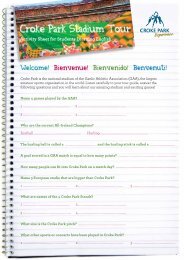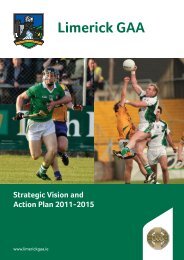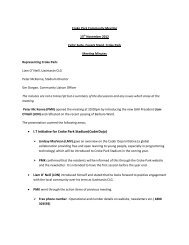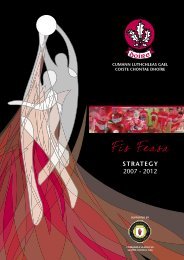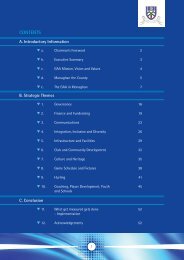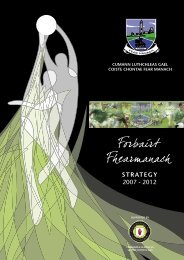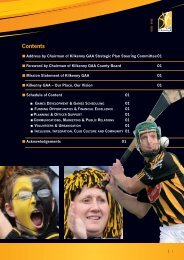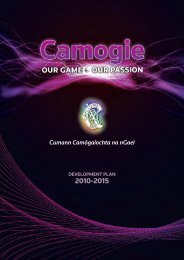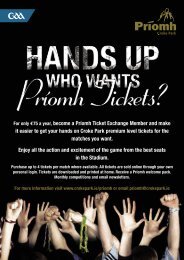Unleashing 'The Blue Wave' A Strategy for Dublin GAA - Croke Park
Unleashing 'The Blue Wave' A Strategy for Dublin GAA - Croke Park
Unleashing 'The Blue Wave' A Strategy for Dublin GAA - Croke Park
Create successful ePaper yourself
Turn your PDF publications into a flip-book with our unique Google optimized e-Paper software.
UNLEASHING “THE BLUE WAVE”<br />
more ‘occasions of sin’ than rural Ireland and it was proving impracticable<br />
to police the regulations. Members of the <strong>Dublin</strong> County Committee<br />
pioneered the propaganda battle, but it was only when the clubs and<br />
counties of rural Ireland joined in support that the rule was jettisoned. The<br />
impact of the rule change is still unclear. The optimism of its proponents<br />
that its removal would lead to a resurgence of Gaelic games in the second<br />
level schools, which traditionally favoured ‘<strong>for</strong>eign games’, was misplaced as<br />
was the pessimism of its defenders that Gaelic games in the cities would be<br />
unable to compete with soccer and rugby. With the passage of time and the<br />
intense specialisation within all sports we have now reached the stage where<br />
dual players at senior inter-county level are banned de facto from playing<br />
both hurling and football.<br />
Within Ireland the emphasis on economic and physical planning developed<br />
apace from the 1960s. The <strong>GAA</strong> set down its response to changing<br />
circumstances in the McNamee Commission report published in 1971. It<br />
was perceived that the complexity of a modern organisation such as the <strong>GAA</strong><br />
could not be efficiently governed according to the structures laid down in<br />
different days. In time governance by committee and professional<br />
administrators, rather than the representative model of delegates from<br />
individual clubs all having a say, became the norm in <strong>Dublin</strong>.<br />
Two coincidences helped the <strong>GAA</strong> in <strong>Dublin</strong> deal with the unprecedented<br />
scale of population growth in the 1970s and later. One was the<br />
farsightedness of administrators who pushed through the re<strong>for</strong>ms<br />
recommended by McNamee and who constantly emphasised to clubs the<br />
importance of having both a ground and a social centre that would anchor<br />
the local community to them. Active intervention rather than a policy of<br />
laissez faire was the order of the day. The County Board was unable to fill in<br />
all the gaps on the map of the <strong>GAA</strong> in <strong>Dublin</strong> and its policy of fixing clubs<br />
in parish/suburbs had disastrous consequence <strong>for</strong> the old ‘gallowglass’ clubs<br />
who were like nations without territories. Time and again throughout the<br />
years clubs evolved rather than being imposed. It was the coming together<br />
of a group who had the faith that was as instrumental in the 1970s as it<br />
was in the 1880s.<br />
The other conjunction was the coincidence of population growth in the new<br />
suburbs with the emergence in the 1970s of what has to be regarded as<br />
<strong>Dublin</strong>’s most successful football team of all times. Fondly remembered as<br />
the golden age of Gaelic football in the capital, the team and its<br />
managers/selectors captured public imagination and became positive<br />
symbols <strong>for</strong> the game and the county. Their youthful dash and flowing style<br />
became the measure by which all those who went be<strong>for</strong>e and those who<br />
came after were to be assessed. Since 1977 the remainder of the century<br />
returned to a kind of struggling normality punctuated by the All-Ireland<br />
victories of 1983 and 1995. Sadly, there was no parallel success in hurling<br />
but the hurlers never lost the faith and the County Board through new<br />
structures and the voluntary commitment of dedicated enthusiasts have<br />
turned the tide with a hurling league title in 2011.<br />
However, when one looks at our clubs they have been very successful at all<br />
age levels.<br />
<strong>Dublin</strong> has enjoyed unprecedented success in the national Féile<br />
competitions. In hurling <strong>Dublin</strong> emerged victorious to claim the Christy Ring<br />
Cup (Division 1), in two of the last seven Féile na nGael finals with<br />
Castleknock’s glory in 2007 coming two years after Kilmacud <strong>Croke</strong>s’<br />
success. Prior to that Ballyboden St Enda’s (1992) had been <strong>Dublin</strong>’s sole<br />
winners of the coveted competition dating back to its inauguration in 1971.<br />
In football <strong>Dublin</strong>’s representatives have enjoyed even greater success in<br />
modern times – being crowned National Féile Peil na nÓg winners on eight<br />
occasions in the last 12 years including the last four years in succession. St<br />
Vincent’s commenced this golden era with victory in <strong>Croke</strong> <strong>Park</strong> in 2000<br />
and St Brigid’s retained the title the following year. Since then Kilmacud<br />
<strong>Croke</strong>s (2003) and St Sylvester’s (2005) also won the Féile title be<strong>for</strong>e the<br />
four in-a-row of Kilmacud <strong>Croke</strong>s (2008), Ballyboden St Enda’s (2009), Na<br />
Fianna (2010) and Ballymun Kickhams (2011).<br />
<strong>Dublin</strong>’s club football champions have prospered in the last decade in the<br />
All-Ireland series and even more so in the provincial club championship. St<br />
16



